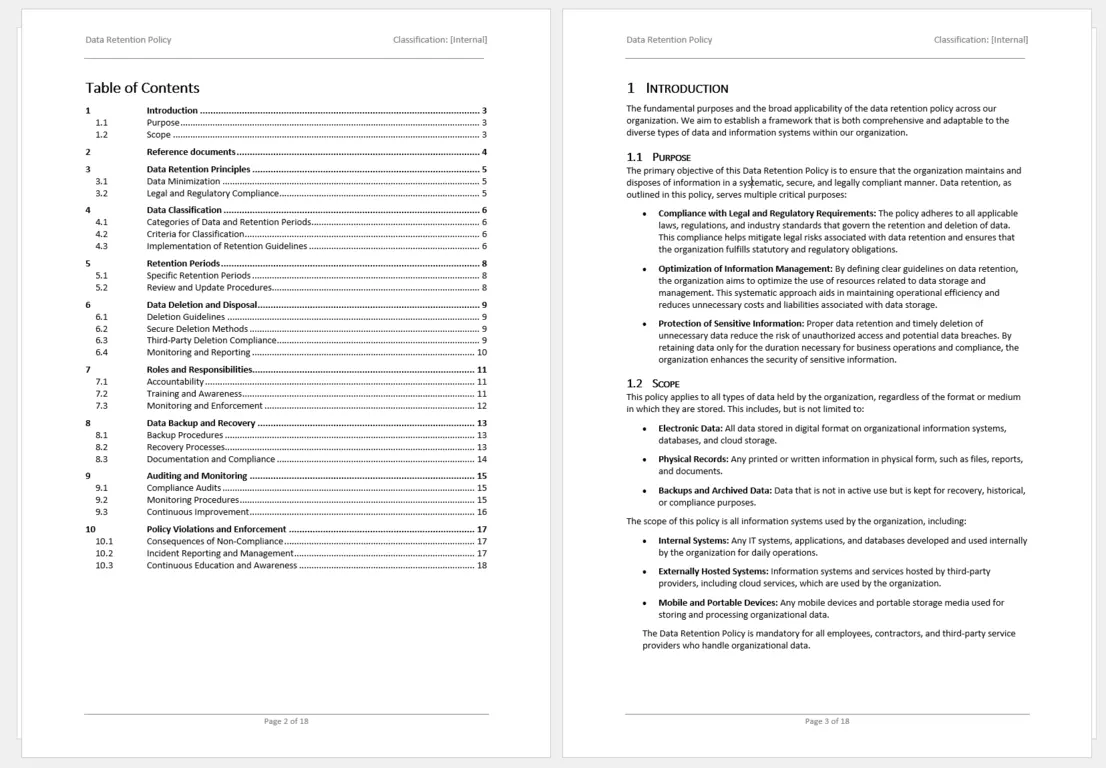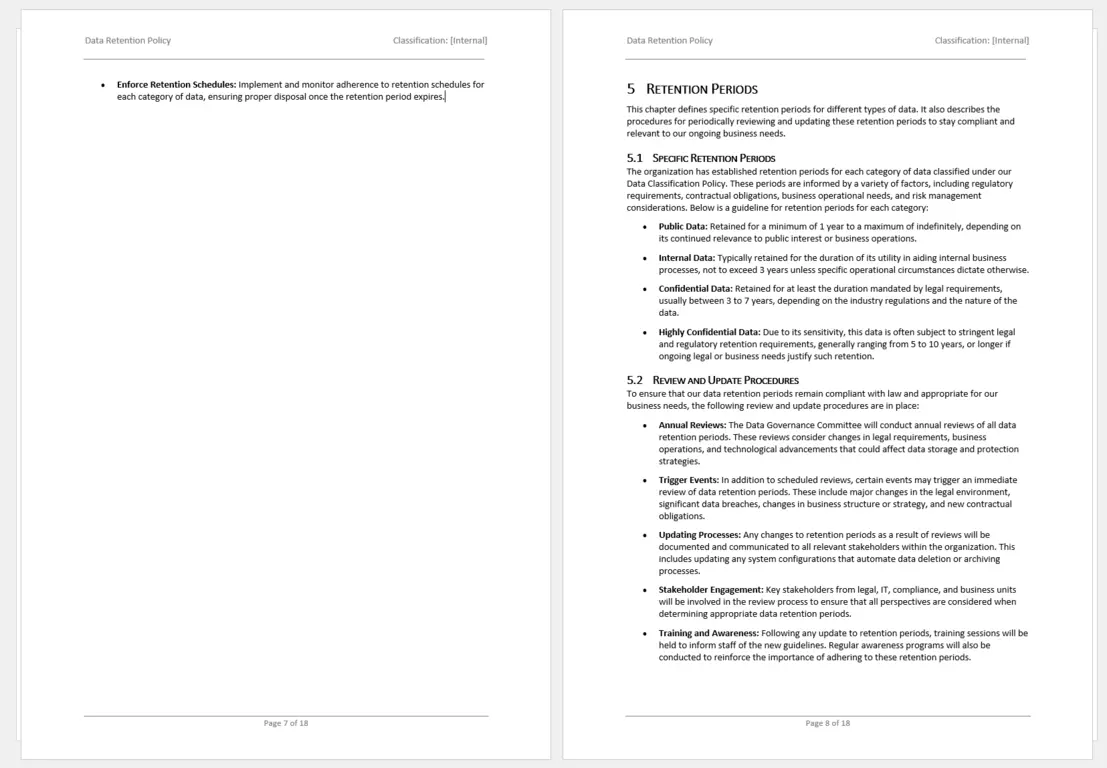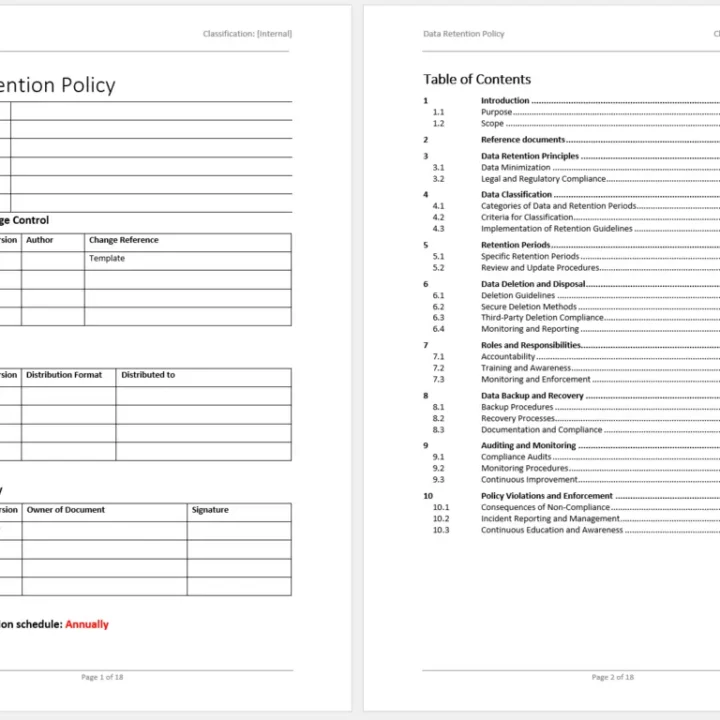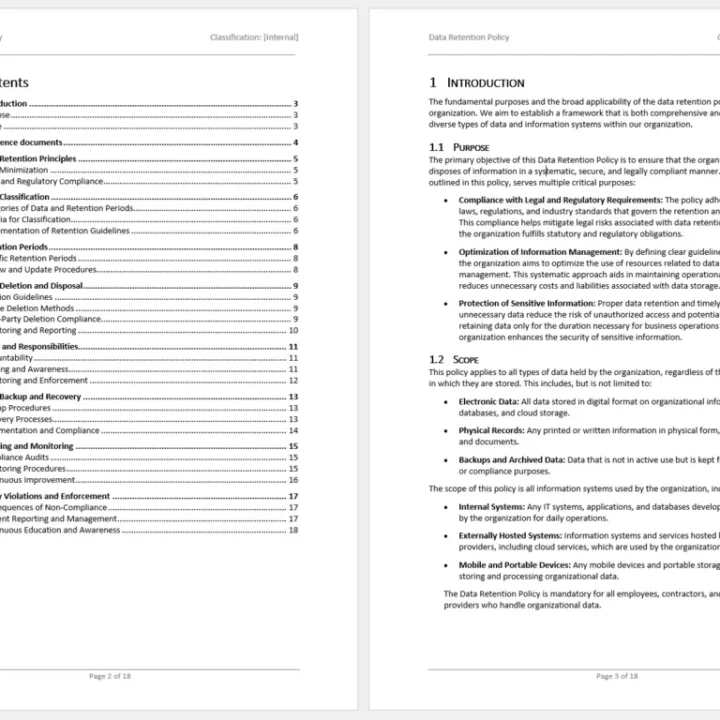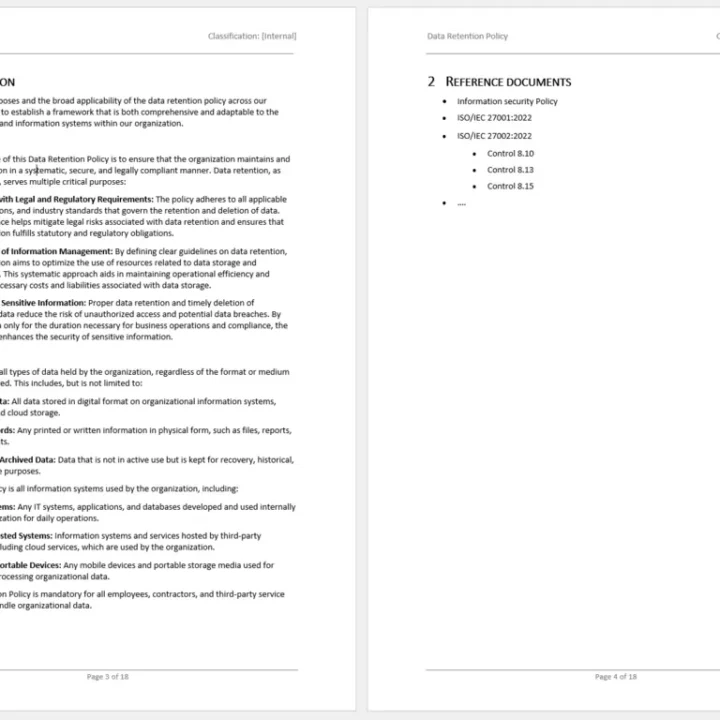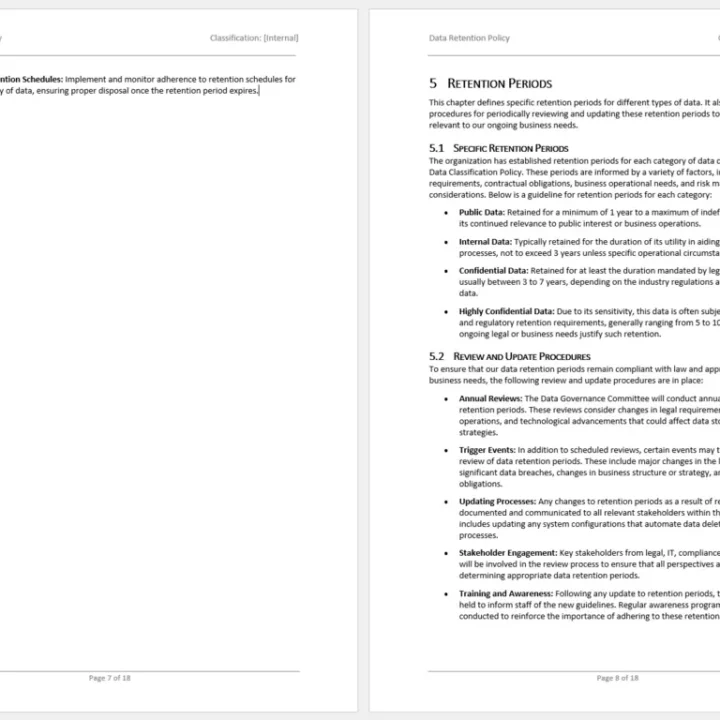ISO 27001 Data Retention Policy Template Word Document
Take control of your data, cut storage costs, and stay compliant with our ISO 27001 Data Retention Policy Template in Microsoft Word format. Written by our CISO’s, it assists with mapping data types to retention schedules, outlining roles and responsibilities, and establishing clear procedures for secure disposal. The template supports a methodical approach to reduce risk, address regulatory obligations, and ensure alignment with ISO 27001 requirements.
Why Choose Our ISO 27001 Data Retention Policy Template?
Our Data Retention Policy Template provides a straightforward, adaptable solution that any business can use to manage data with confidence. With this template, you get a complete framework for organizing, securing, and controlling your data.
Alignment with ISO 27002 Control 8.10
Control 8.10 focuses on the secure deletion of information that is no longer required. This ISO 27001 data retention policy template aligns with those guidelines by detailing the choice of deletion methods, logging of disposal events, and integration of deletion requirements into third-party contracts. The template prioritizes the importance of not keeping sensitive data beyond its required retention period and includes steps to document and verify all deletion activities.
Features and Benefits
-
Customizable to Your Business Needs
This template isn’t one-size-fits-all. It’s designed to be customized according to your industry, business size, and specific compliance needs. Whether you’re in healthcare, finance, or tech, you can easily modify sections to suit your data types, retention requirements, and regulatory standards.
-
Concept Retention Schedule
The template includes a retention schedule to keep your data organized and compliant. This schedule is your reference point, showing exactly what data to keep, for how long, and where it’s stored.
-
Secure Data Archival and Deletion Protocols
Data security doesn’t end at storage — it also includes knowing when and how to dispose of data. The template includes secure archival and deletion protocols, detailing methods like cryptographic erasure and data shredding to ensure sensitive data is properly disposed of.
-
Easy-to-Follow Layout
You don’t need to be a data expert to use this template. It’s designed with a simple, intuitive layout that guides you step-by-step through the data retention process.
-
Ready for Compliance with Major Regulations
From GDPR to HIPAA, data regulations are a reality for nearly every business. This template is made to assist with alignment major compliance standards.
Who Should Use This Template?
This template is especially useful for teams responsible for data compliance, security, and record-keeping. Compliance teams will appreciate the legal citations and regulatory alignment; IT teams will value the secure deletion guidelines and platform-specific guidance, and legal teams will benefit from the clear documentation of data handling practices.
For Businesses of All Sizes
From startups to large enterprises, this template is adaptable to businesses at any stage. Smaller businesses can use it to build a foundational data retention strategy, while larger organizations can refine and expand their existing practices. The customizable nature of this template makes it a versatile choice for any organization looking to handle data effectively and responsibly.
-
Reduces Costs and Streamlines Data Management
With a clear policy in place, your business can avoid excessive storage costs and wasted resources. By cutting down on unnecessary data, you not only reduce storage expenses but also enhance operational efficiency. This template makes it easy to manage only the data that matters, helping your team save time and focus on what’s important.
-
Minimizes Security Risks and Legal Liabilities
Excessive, unorganized data can make your business a target for cyberattacks and legal issues. By establishing a clear data retention and deletion schedule, you reduce the volume of stored data, lowering your risk profile. Secure deletion protocols and role-based access controls help you manage data responsibly, protecting both your business and your customers.
-
Improves Employee Awareness and Accountability
Data retention is a team effort. This template sets out clear roles and responsibilities, so everyone involved understands their part. By assigning specific tasks to relevant departments and individuals, you enhance accountability and create a culture of data awareness. Your team will know exactly how to handle, store, and delete data, which is crucial for reducing risk and staying compliant.
-
Designed with Long-Term Flexibility in Mind
Data retention needs change over time, and our template is built to adapt. With sections you can adjust as your business grows and as new regulations come into play, you’ll be able to keep your data retention policy relevant and effective for years to come. A solid policy isn’t static; it’s flexible, and this template helps you stay agile.
How to Use This ISO 27001 Data Retention Policy Template
Our ISO 27001 Data Retention Policy Template is made to make implementing an effective data retention policy as straightforward as possible.
Step 1: Identify Data Sources and Classify Data
Begin by taking inventory of all data sources in your organization, including both cloud applications and on-premises systems. Document each type of data your business collects and categorize it based on its sensitivity and relevance. Use classifications like “confidential,” “proprietary,” and “public” to organize data and align with your organization’s privacy and security policies. If you need a template for Data Classification, check out our Data Classification Policy Template.
Step 2: Determine Legal and Compliance Requirements
Work with your legal and compliance teams to determine the laws and regulations that apply to each data type. Whether your organization is subject to GDPR, HIPAA, CCPA, or industry-specific regulations, this step ensures you’re aligned with all applicable data retention standards.
Use the template to:
- Assign retention periods based on legal and regulatory requirements.
- Note any specific citations to reference in case of an audit or legal request.
Step 3: Set Retention Periods and Develop a Retention Schedule
This should be a balance between compliance obligations and operational needs. Some data may require short-term retention, while other records must be kept long-term for compliance or business purposes.
The retention schedule allows you to:
- Document each data type’s retention period and the reason behind it (legal, operational, or both).
- Create a clear timeline that helps employees understand data life cycles.
Step 4: Establish Secure Archival and Deletion Protocols
After defining retention periods, it’s essential to set out the processes for archiving and deleting data. Use the template to detail how each data type will be archived and what methods will be used for secure deletion. .
The archival and deletion protocols include:
- Archival methods for data that must be retained beyond initial usage.
- Deletion methods that protect data integrity, such as data shredding and cryptographic erasure.
Step 5: Assign Roles and Responsibilities
Successful data retention requires clear accountability. Using the template, assign specific roles for data custodians, IT, compliance, and any other departments involved.
Roles and responsibilities include:
- Naming data custodians for each data type or category.
- Assigning oversight duties to IT and compliance teams to monitor data access and retention timelines.
Step 6: Implement Privacy and Security Measures for PII
For organizations handling Personally Identifiable Information (PII), additional privacy and security controls are essential. The template includes dedicated sections for managing PII securely and following any additional regulatory guidelines.
Privacy controls include:
- Access restrictions and encryption guidelines for PII data.
- A record of data types containing PII to facilitate quick response to data requests.
Step 7: Set Up Legal Hold Procedures
Data retention policies must adapt in the event of legal proceedings. The template includes guidance for handling legal holds, ensuring that relevant data is preserved and not altered or deleted.
Legal hold procedures provide:
- A structured process for suspending data deletion during a legal hold.
- Documentation of preservation efforts to show compliance during litigation.
Step 8: Train Employees and Promote Compliance
Effective data retention requires employee understanding and support. Once your policy is in place, conduct training sessions to familiarize your team with the policy’s essentials, including data categories, retention timelines, and deletion procedures.
Training efforts should cover:
- Key data handling procedures for compliance and security.
- Real-life examples to help employees understand the importance of proper data management.
Step 9: Regular Monitoring and Policy Updates
Data retention is not a one-time task; it requires regular monitoring to stay effective. Set up periodic reviews using the template as your central document to ensure retention periods, storage locations, and security measures are always up to date with evolving regulations and business practices.
Ongoing monitoring includes:
- Monthly or yearly policy reviews to identify any needed adjustments.
- Updates based on changes in data regulations or internal business processes.
Why your Business Needs a Data Retention Policy
Built for any business, this template helps you comply with data laws like ISO 27001, GDPR, CCPA, and HIPAA, reduce risks, and make data work for you, not against you. It’s a straightforward way to control data retention, cut costs, and protect your business.
Understanding Applicable Data Retention Laws
Legal requirements often take precedence over business needs, so a clear understanding of relevant laws and regulations is a critical first step. Consulting with your legal and compliance teams ensures that your data retention strategy is compliant from day one. In many cases, multiple laws and regulations will apply, sometimes with conflicting requirements. In these situations, it’s important to document instances where conflicts may arise and have a clear plan to address them — one you can share with courts or regulators if necessary.
Here are some key laws and regulations to consider:
- Bank Secrecy Act (BSA): Financial institutions must retain records for five years, including specific consumer identification information.
- California Consumer Privacy Act (CCPA) and California Privacy Rights Act (CPRA): While no specific data retention period is set, companies must disclose retention periods or criteria for personal information (PII). The CPRA requires businesses to limit data retention to what’s necessary for their stated purpose.
- Children’s Online Privacy Protection Rule (COPPA): Businesses can only retain information on children under 13 as long as needed for the intended business purpose and must securely delete it afterward.
- Equal Employment Opportunity (EEO) Act: Employers must retain personnel records for at least one year, with specific guidelines for terminated employees.
- eIDAS Regulation (EU): For electronic transactions in the EU, this regulation covers electronic identification and trust services. Companies providing these services must retain records, including consent and transaction details, for periods defined by local laws.
- Family Educational Rights and Privacy Act (FERPA): Requires educational institutions in the U.S. to retain student records for a period determined by state regulations, typically for five years after a student leaves the institution.
- Fair Labor Standards Act (FLSA): Payroll and work-related records must be kept for up to three years, with certain items like wage computation data held for two years.
- General Data Protection Regulation (GDPR): Data on EU citizens must be retained only as long as it’s necessary and for clearly defined purposes.
- Gramm-Leach-Bliley Act (GLBA): Financial institutions must securely dispose of customer information within two years unless otherwise required.
- Health Insurance Portability and Accountability Act (HIPAA): HIPAA requires related documents to be kept for a minimum of six years, with state-specific retention rules also applying to medical records.
- Occupational Safety and Health Act (OSH Act): Employers with more than ten employees must retain certain records, such as injury logs, for at least five years, with different requirements for exposure records.
- Payment Card Industry Data Security Standard (PCI DSS): Organizations handling cardholder data must dispose of it once it’s no longer needed for legal or business purposes, ensuring multiple layers of protection.
- Sarbanes-Oxley Act (SOX): Public companies must retain audit records for at least seven years.
Common Questions
How to Write an ISO 27001 Data Retention Policy?
- Key steps: Identify where data resides, categorize and classify it, understand retention laws, and outline secure deletion practices.
- Our template provides a ready-to-use framework for each step, making the process straightforward and adaptable.
What is Included in a Data Retention Policy?
- Essential elements, including a data retention schedule, compliance mapping, archival and deletion guidelines, and security protocols.
- Customizable sections for specific data categories and retention periods according to regulatory requirements.
What is the Ideal Data Retention Policy?
- An effective policy is thorough yet adaptable, aligned with both legal obligations and business needs.
- The ideal policy also includes mechanisms for regular monitoring and easy updates as regulations and business practices evolve.
How to Write a Data Retention Policy?
Writing a data retention policy may seem complex, but by breaking it down into clear steps, you can create an effective policy that’s tailored to your organization’s needs. Here’s a quick guide:
- Identify Where Data Resides: Start by listing every app, cloud service, and internal system that holds your data. Knowing where your data lives is essential for managing it properly.
- Categorize and Classify Your Data: Organize data into categories based on type, sensitivity, and business relevance. This makes it easy to apply retention rules and security measures accordingly.
- Understand Retention Laws and Compliance Needs: Determine which data protection laws apply to your business, whether it’s GDPR, HIPAA, or industry-specific regulations. These requirements dictate how long certain data types should be retained.
- Outline Secure Deletion Practices: Establish clear guidelines for deleting data securely when it’s no longer needed, ensuring sensitive information is fully erased to prevent unauthorized recovery.
How to Use the Template Effectively?
Maximizing the value of this template requires a few essential steps and collaboration across teams:
- Involve Key Departments: For a seamless setup, work closely with your IT, compliance, and legal teams. Each department brings valuable insights into data handling, regulatory requirements, and security measures, ensuring that every aspect of your data management is covered.
- Establish Regular Monitoring: A successful data retention policy is a living document that adapts to changes in regulations and business needs. Schedule periodic reviews to verify that retention periods, deletion protocols, and compliance mapping remain accurate and relevant. This step ensures your policy’s long-term effectiveness.
What are the Best Practices for ISO 27001 Data Retention Policies
Writing a strong data retention policy means more than just setting retention periods. Here are some best practices to keep in mind:
- Keep Retention Periods Clear and Practical: Overly complex or arbitrary retention periods can lead to confusion and errors. Aim for simplicity by setting clear, legally compliant retention timelines that align with both regulatory requirements and business needs.
- Plan for Regular Policy Reviews: Laws and regulations around data retention are constantly evolving. By establishing a schedule for regular reviews, you can ensure your policy remains up to date and in compliance with the latest legal standards. This approach also helps identify areas where efficiency can be improved over time.
Why Invest in our ISO 27001 Data Retention Policy Template?
It’s a vital part of business strategy, security, and cost management.
- Meet Legal Obligations with Confidence: A well-defined data retention policy helps you meet legal requirements effortlessly, reducing the risk of penalties or reputational harm from non-compliance.
- Reduce Storage Costs and Minimize Security Risks: By only retaining necessary data, you avoid excessive storage costs and reduce your vulnerability to security breaches.
- Support Business Continuity: An organized, compliant data retention policy can save your business millions in potential breach costs, litigation expenses, and operational disruptions. It keeps data accessible and managed, which is essential for smooth business operations and informed decision-making.
Take Control of Your Data Retention
Download our ISO 27001 Data Retention Policy Template now and take the first step toward a secure, compliant, and organized data management strategy.

